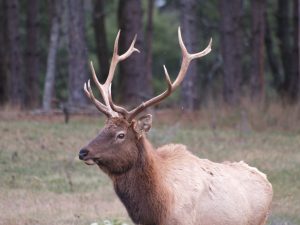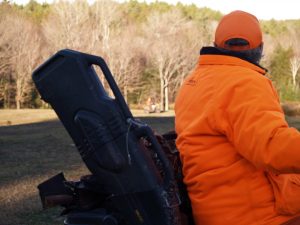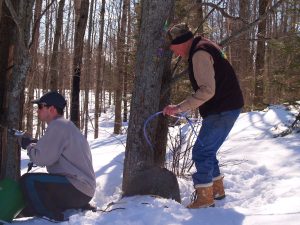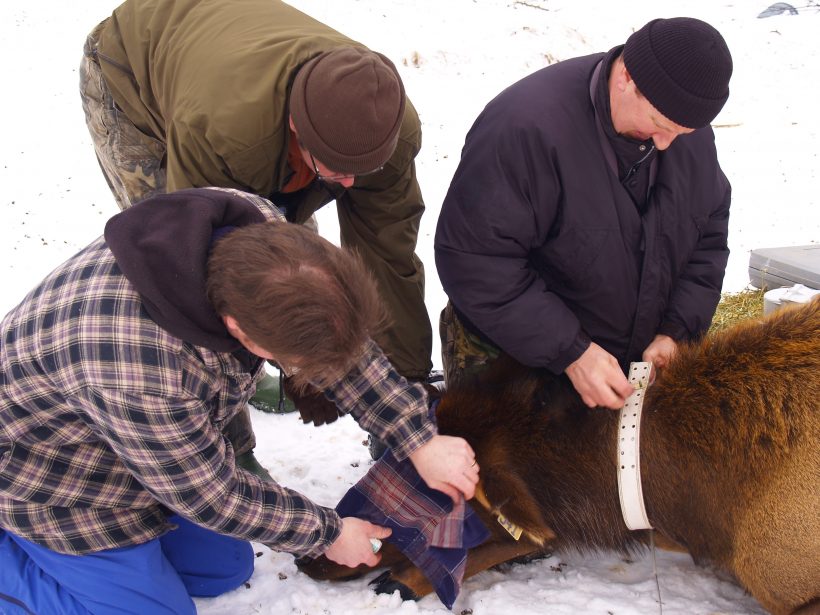OUT of DOORS with BARNEY MOORHOUSE For Reproduction Rights call Access 1.800.893.5777
HUNT & RELEASE?
During the Christmas season, while listening to the CBC’s special programming, I heard an episode featuring two hunters from northern Ontario who had begun their own version of Hunt & Release. Simply they would shoot an animal with a tranquilizer– from squirrel to moose – take its photos and photos of themselves with the animals – and then release them to the wilds. Where they would get the drugs, darts, specialized guns and knowledge to do so left me wondering for I’ve seen the exactness with which ministry personnel carry out such a task. So, I did some research in an attempt to find these guys. No luck. So I turned to the MNR which responded:
“This practice is prohibited under the Fish and Wildlife Conservation Act, 1997 and would not be legal in the province of Ontario.”
Tongue in cheek. But I’m sure I am not the only one who had pause for some thought.
On a similar note the MNR recently recycled a GPS elk collar taken from an elk shot during the September hunt as part of an ongoing study to determine where the cows are calving. Surely the elk in our neighborhood must be among the best and most thoroughly studied animals in North America?
One volunteered suggestion for the elk hunt worthy of consideration is to follow the example of the Algonquins of Golden Lake and extend the hunt for a longer period of time to avoid a similar situation to this year’s unseasonably warm weather. As in all new programs experience helps to iron out the wrinkles.

OF ELK ANTLERS
Antler cycles vary with age. Calves rarely complete an antler cycle; yearlings begin growth in June/July and end near the end of August/mid-September when they shed the velvet. The growing phase is 90 days – give or take 10. Two year old bulls grow a 2nd set from late April to early May (during turkey season) for some 115 days – give or take 10. They cast their antlers from March to mid-April. Three/four year old bulls living in well organized populations where sexual stimulation is not prolonged can cast their antlers from February to mid-March. Their antler development is 140 days – give or take 10. Prime bulls, if well fed and sexually inactive since mid-October, can cast antlers as early as mid-January/late February. Their antler growth period is 150 days – give or take 10. Prime bulls joining cow herds mid-winter may delay casting about 10-20 days due to sexual stimulation. Sexually relaxed prime bulls may cast earlier than young, sexually repressed bulls. FYI.

SPORT-WASH
T’is the time of year to care for your hunting clothing. Especially the hunter orange variety. Under the watchful eye and guidance of The Resident Wife (TRW) I soak my hunting coat in the laundry tub for the better part of the day to loosen up any dirt and soil. During the course of the day I’ll agitate the soaking clothing by hand. In order to save on hydro electrical expense I wait until 7 pm before putting the coats on a delicate short cycle in the washing machine. Balance is important to prevent the washing machine from dancing all over your laundry room floor. TRW checks this part of the operation closely by stopping and starting the agitation process. Simply put the pattern is turn on the machine for agitation – stop to soak some more – agitate – soak….until the short cycle is complete. I always use Sport-Wash as it helps to eliminate the UV rays that light us up like neon signs for wildlife to see. This product is more widely available now and has been tested at the university level in the US. It leaves no residue, restores breathability, wicking action and water repellency. Oh, you may wish to pay some special attention to both the cuffs and the ring around your collar.
By looking after your favourite clothing it will perform better, last longer and improve your comfort.
FISHING AND HUNTING LICENCES
Apparently, as the MNR moves to an internet-based licensing system several retailers are bailing out of the added expense. The ministry will provide the computer terminal but licence issuers will need a fax line or upgrade their internet access at their own expense. One retailer said he gets between 75 cents and $1.25 per licence and it takes 5-10 minutes to process one. Another retailer who has stopped issuing licences said she wasn’t concerned about any loss of business because people would often drop in to purchase a licence and then leave without any other additional purchases. People didn’t realize that the retailer was providing a convenience by selling the licences. Of course people with computers can go on-line to purchase a licence. The good news for those 65+ is that they don’t need a fishing licence. Perhaps the MNR could add a small game licence to that?

ONTARIO MAPLES at RISK?
The Environmental Commissioner of Ontario (ECO) Gord Miller has rung the alarm bell that the McGuinty government needs to generate a new plan to deal with serious threats or risk the loss of many native species – such as our sugar maples. “We could lose black spruce in northern Ontario. We already have a major crisis in our fisheries in the Great Lakes.” (Asian Carp, mercury…) The province is “ill prepared” to meet the challenge said Miller. An invasion of Asian long horned beetles from New York State is threatening the maples.
On a similar note mercury levels are rising in the Great Lakes as evidenced in both fish and birds and health problems are happening at lower concentrations than anticipated. Common loons (impaired egg fertility) and walleye are among those observed to have increasing levels of mercury.
AND FINALLY…
The only 15 letter word that can be spelled without repeating a letter is uncopyrightable. Anon
